Enjoy DatePsychology? Consider subscribing at Patreon to support the project.
According to Incel.wiki, “Gigachad is a 10/10 Chad who is within the top 0.01% of physical attractiveness.” Incelwiki.org similarly says, “[Gigachad] typically ranks as a “10” on the decile scale.” These were two of my top search results for “Gigachad” on Google. They capture the popular meme well: the Gigachad is the epitome of the physically attractive man.

The only problem is, well, the Gigachad doesn’t actually seem to be rated as attractive by women.
In this article I will share my results from a recent survey of men and women who rated the Gigachad’s facial attractiveness. I will then review the current literature on two topics: interrater agreement on facial attractiveness ratings and the relationship of facial sexual dimorphism (facial masculinity) with facial attractiveness.
The current survey
I conducted a short survey of men and women on Twitter and YouTube. I asked participants to rate the Gigachad’s photo (above) on a 7 item Likert scale. My hypothesis — men would rate the Gigachad as attractive, but women would not. This turned out to be the case. Below are my results.
Descriptive statistics
I recruited 237 participants via combined web form and snowball sampling beginning on my Twitter and YouTube accounts. Of these 76 (32%) were women, 158 (67%) were men, and 3 (1%) reported as other. I excluded participants who identified as other due to the small number for a remaining total N = 234. Men had a mean age of 30 (SD = 11.4) and women had a mean age of 30 (SD = 10).
Statistical analysis
I used base R with ggplot to plot density and histogram charts for the relationship between gender and ratings of facial attractiveness. As this was a Likert scale, non-normality was expected in the distribution and confirmed with a Shapiro-Wilk Test (W = 0.89, p-value < 0.001). I selected a two-sided Wilcoxon Rank Sum Test to compare independent samples.
Results
Women rated Gigachad lower (3.58) than men (4.88). This was statistically significant (W = 8208, p < 0.001). As this was a 7 point scale, the midpoint on this scale was 4. The average rating given by women was below average.

As Likert scales may not fall on normal distributions (Is Physical Attractiveness Normally Distributed), the means do not tell the full story. This can be seen in the density plot below.

Gigachad’s face was polarizing for both men and women. Men and women returned very few midpoint or Average ratings. However, female ratings clustered most around Unattractive (2 out of 7), while male ratings clustered most around Attractive (6 out of 7). Men thought that Gigachad was quite a handsome fellow, but women did not.
Put another way, 38% of women rated the Gigachad between Slightly Attractive to Very Attractive, while 59% of women rated the Gigachad between Slightly Unattractive to Very Unattractive.
If we close in on the bottom or top categories — the 6/7 and 7/7 ratings — this was only 24% of women. Fewer than one quarter of women viewed the Gigachad as a Chad at all!
39% of women rated the Gigachad between a 1/7 and a 2/7.
To compare, 46% of men rated the Gigachad a 6/7 or 7/7 and 14% of men rated the Gigachad as a 1/7 or 2/7.

Interrater correlations of facial attractiveness
Langolis et al. (2000) remains the most cited meta-analysis on interrater agreement on facial attractiveness. Within a given culture, adults have high agreement (.90), as do children (.85). Across ethnicities and cultures agreement is also high (.88). However, this meta-analysis had high effect size heterogeneity. This means individual studies varied often in their results, or in the size of effects. Individual studies did not always find similar correlations. Further, this meta-analysis was primarily of average ratings — how raters agreed overall. Ratings between individuals or pairs may be much lower (they are, as we will see below).
Hönekopp (2006) found interjudge agreement between .34 and .57 across a series of studies on facial attractiveness. The role of private and shared taste was explored for men and for women. Private taste predicted ratings of facial attractiveness for men better (.60) than it did for women (.39). Private taste explained about 30% of the variance for cross-sex ratings, or ratings of women to men. This was similar to the variance explained by shared taste. Or, in other words, shared and private taste explained an equal amount of variance in facial attractiveness ratings. Beauty is neither entirely subjective nor entirely universal.
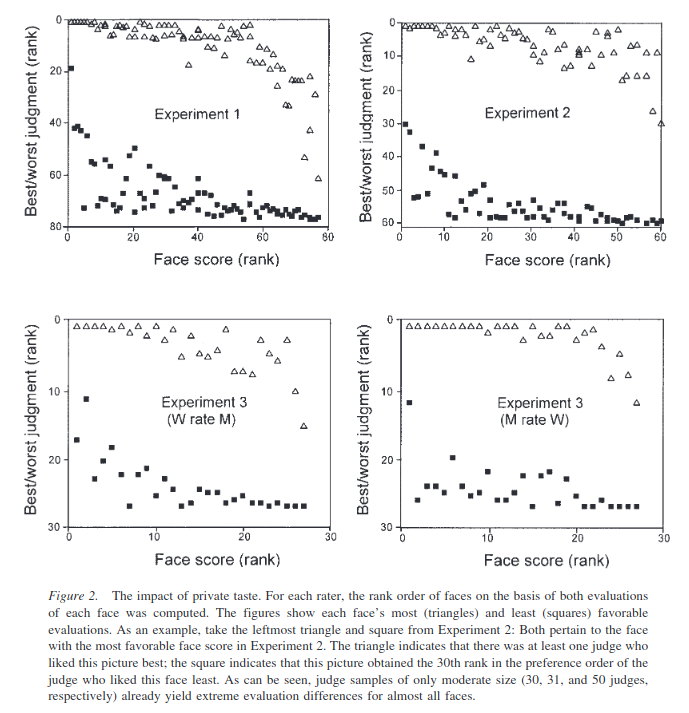
Bronstad et al. (2007) examined facial attractiveness ratings by strangers, friends, siblings, and spouses. Spouses had the highest interrater correlation, with an r-squared of .42. This was inconsistent with hypotheses of a strong genetic basis for perceptions of facial attractiveness.
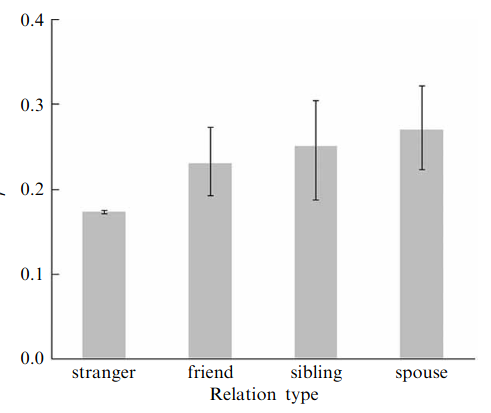
Germine et al. (2015) conducted a study of monozygotic (MZ, or identical) and dizygotic (DZ, or fraternal) twins. Twin study methodology allows estimates of heritability, commonly interpreted as genetic contribution. As with Langolis et al. (2000), mean correlations were very high — .99! This was true both within and across gender. However, the average between-individual agreement was 48%.
In Germine et al. we can see another example, as with Hönekopp (2006), of how mean ratings may inflate perceptions of agreements on what is attractive. Individual agreement on what faces are attractive is substantially lower than mean agreement.
For MZ twins, facial attractiveness ratings correlated at .22, while for dizygotic twins, facial attractiveness ratings correlated at .09. This was not statistically significant. Approximately 22% of the variance in facial attractiveness ratings was estimated to be heritable, while the remaining 78% was attributed to nonshared environment. The heritability of perceptions of what is beautiful seems to be low. We will see a similar heritability estimate in the section below on sexual dimorphism and attractiveness.
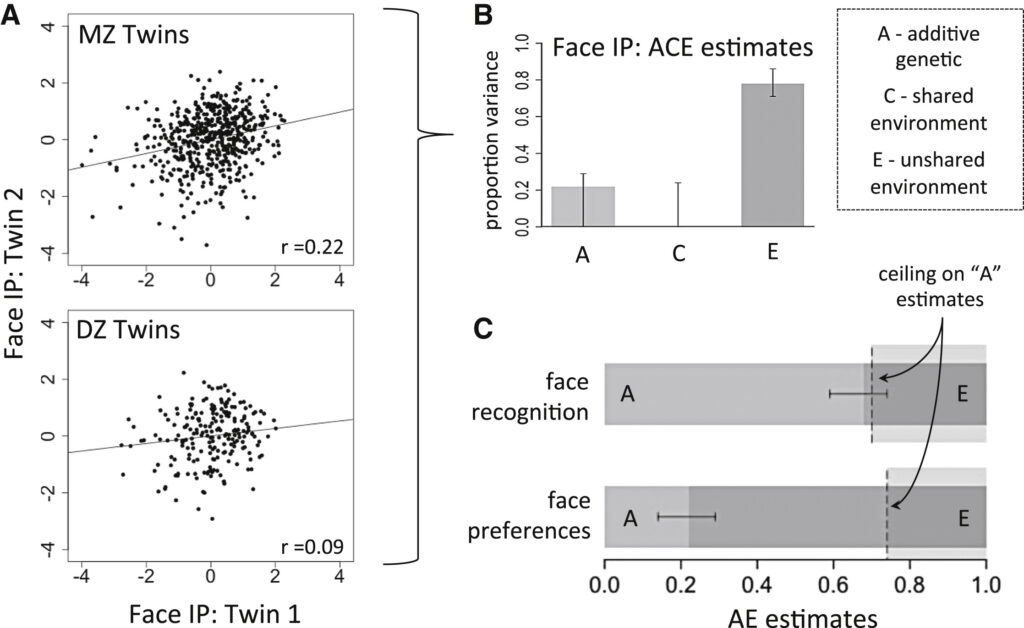
Kościński et al. (2010) also found lower inter-individual agreement on facial attractiveness than mean group agreement would indicate. Inter-individual agreement correlated at .5, with facial attractiveness explaining approximately 25% of the variance in ratings given by individual judges.
Lavan et al. (2021) found high mean rater agreement (.81), consistent with previous facial attractiveness research. In a two-way random effects model, this dropped to .61 for absolute agreement between raters.
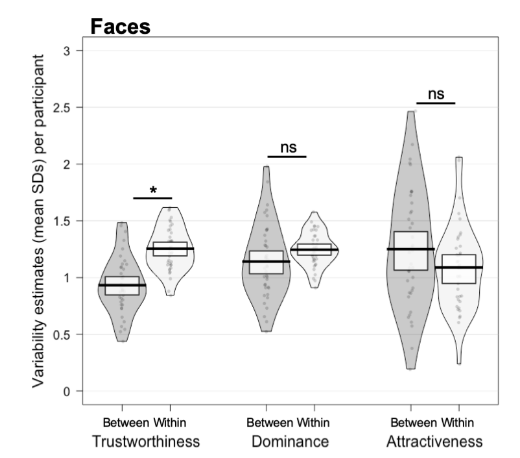
Revisiting Kościński et al. (2010) we must introduce another concept as well — test-retest agreement. Do people consistently agree with themselves on facial attractiveness when asked a second time?
Test-retest for facial attractiveness was .61 across two sessions. This is not small, but it is worth keeping in mind when thinking of how we view faces. Perceptions of facial attractiveness can shift substantially over a short period within the same observer. You might find someone more attractive today than you found them last week.
Marcus & Miller (2003) conducted a study of attractiveness with an in-person interaction methodology. This was not exclusive to faces, but was a rating of unspecified attractiveness based on a real life interaction. I wanted to include this to give you an example of how it may compare with facial ratings. Male target attractiveness accounted for 31% of the variance in ratings of attractiveness by women, with correlations of .71 on male attractiveness between men and women.
What we have seen up to this point is that while attractiveness is not subjective or random, attractiveness is also not absolute. Individuals vary more in ratings of attractiveness than the mean ratings of groups indicate. This effect can be seen in the Gigachad survey results. Viewing the boxplots, or just comparing means, might not show you the whole picture about how much individuals disagree about a face.
Culture and facial attractiveness
Examining cross-cultural datasets helps us to get an idea of how universal a trait may be. If we see agreement across cultures it may a piece of evidence indicating the universality of a human trait. The research up to this point has been primarily on WEIRD (Western, Educated, Industrialized, Rich and Democratic) samples, or the Anglosphere, with the exception of Langolis et al. (2000).
How far do other cultures agree on what is beautiful within those cultures? Do we agree on what is beautiful across cultures?
Zebrowitz et al. (2011) conducted facial attractiveness research on the isolated Tsimane people of the Bolivian rainforest and US Americans. They found similar agreement within the Tsimane sample for Tsimane (.50) and US (.43) faces. The US sample agreed more on what faces were attractive, but similarly across different-culture faces, for Tsimane (.68) and US (.78) faces. Although the correlation between US Americans and Tismaine was high for US faces (.50), it was lower for Tsimane faces (.29). Here we can see within-cultural variation both in the extent to which attractiveness may be agreed upon and between-culture variation in perceptions of attractiveness.
Notably the size of these correlations was not extremely different from within-culture WEIRD samples. Zebrowitz et al. (1993) also found cross-cultural correlations of US Americans and Koreans at .64. Jones & Hill (1993) found the same correlation at .64 between US American, Brazilian and Russian samples.
Coetzee et al. (2014) examined correlations between facial attractiveness ratings in Scottish and African samples, finding some asymmetry. Cross-cultural mean correlations were similar to the research up to this point: .62. While both African and Scottish participants had high agreement (.70) on the attractiveness of Scottish faces, the correlation was lower for African faces (.37).
Up to this point we have examined to what extent we agree on facial attractiveness — how we agree on average, how we agree with specific individuals and how far we agree with our past ratings over time.
Let’s look more in depth on agreement (or disagreement) about masculine faces.
Facial masculine dimorphism and facial attractiveness
Sexual dimorphism refers to sex-based general differences between men and women. For example, the average larger size of men is a dimorphic trait.
We express dimorphism in our faces. Men have more robust brows, larger jaws and more facial hair. Women have more fat in their lips and cheeks. There are many more examples. We tend to recognize masculine and feminine features on an intuitive level.
As these are sexually dimorphic traits it has been hypothesized that they have a relationship with sexual attractiveness.
When it comes to facial dimorphism in women — women who have more feminine facial traits — results are consistent. Men and women both report more feminine faces to be more attractive (Rhodes, 2006). For men and masculine facial dimorphism, however, the results are inconsistent or mixed. We occasionally see facial masculinity predictive of higher attractiveness, occasionally lower, and sometimes having no relationship at all.
Rhodes et al. (2006) is the most cited meta-analysis on the relationship between facial sexual dimorphism and attractiveness. Rhodes found a small negative association (-.12) with facial masculinity and the attractiveness of male faces. Average faces (dimorphically average, not of average attractiveness) were more attractive (.64).
In a more recent meta-analysis of 56 effect sizes, Chen et al. (2017) found no preference for masculinity or femininity in male faces. This is a meta-analytic result we can expect if there is either high heterogeneity (mixed results in both directions), or if there is no true effect at all.
Imagine the most dimorphic male face you can. It will look like a gorilla. Intuitively, this is not attractive. It is understandable if the most dimorphic faces are rated as less attractive. However, there is a lot of nuance we must consider when interpreting the findings of these meta-analyses and the subsequent papers.
Methodological limitations in research on facial attractiveness and sexual dimorphism
When you begin to read research on facial dimorphism you may notice a confound in the methodology: a great deal of dimorphic faces are computer edited. Researchers edit faces to make them more (and less) masculine. They are not natural faces. This may contribute to why more masculine dimorphic faces are often rated as less attractive.
If you’re thinking “hey, that’s stupid methodology,” please keep in mind — this methodology also allows you to control for confounds. It allows you to use the exact same face across conditions. Attractiveness ratings of natural faces do not. When using natural faces, participants compare the faces of different people. Those faces may be more or less attractive for many reasons. Thus, it isn’t stupid methodology. It just has trade-offs.
There is another methodological point to consider: much facial attractiveness research on dimorphism uses just one face per study. When we compare effects across studies we are also comparing ratings of different faces. Individual differences in faces may account for different results across studies.
Results of research on facial attractiveness and sexual dimorphism
De Lurdes Carrito (2016) found that when women were allowed to adjust the masculinity of a face — imagine a character creation slider in a video game — they turned the masculinity down. In fact they reduced masculinity a lot, by about 40%, for a large Cohen’s d effect size of -1.5.
In Zuo et al. (2019), women preferred edited faces that were more feminine. These faces were rated about one point higher on a 7 point Likert scale. O’Connor et al. (2012) similarly found a preference for male faces that had been edited to be more feminine.
Hill et al. (2013) found no relationship between attractiveness and facial masculinity. However, when facial girth was manipulated to make faces wider, more dimorphic faces were seen as less attractive (-.39).
Li et al. (2021) manipulated the faces of participants to be more or less masculine. Men rated their own faces to be more attractive when manipulated to be more masculine. However, women did not rate men’s faces to be more attractive following the masculinization manipulation. Clarkson et al. (2020) similarly found that unedited faces were rated as more attractive than edited faces. This is in line with my Gigachad data which indicates a male preference for men’s masculinized faces that women do not share.
Thompson & O’Sullivan (2013) used natural faces that were pre-rated for masculinity. Unlike much of the research using computer manipulated faces, natural faces rated high in masculinity were more attractive (.45) than average and low masculinity faces. Highly masculine faces were twice as attractive as faces rated at the lowest level of masculinity! Additionally, women rated masculine faces as more desirable for both short term (.23) and long term (.26) relationships. This is contrary to what would be expected in the ovulatory shift or dual mating hypothesis, where facial masculinity signals “good genes” for short term relationships. (See: Why dual mating hypothesis research has failed to replicate.)
Renneis et al. (2008) used a similar methodology with pre-rated masculine faces and found a positive effect for masculinity with a similar size (.36). Naturally masculine faces were rated as more attractive than faces edited to appear masculine. In case you were wondering about pre-ratings of masculinity, interrater agreement was also very high (.97 for male faces, .98 for female faces). People seem to agree on what a masculine face is about as much as they agree on what an attractive face is.
DeBruine et al. (2010) replicated Renneis et al. and found the same relationship between pre-rated masculinity and attractiveness. However, when photographs were edited to remove hair, neck, and background the relationship disappeared.
Masculine vs dimorphic
This raises another question — are people really rating the most dimorphic faces as the most masculine? The terms dimorphic and masculine are often used interchangeably in the literature. I have used them similarly here. It could be the case, however, that the faces we perceive as more masculine may not be more dimorphic. If this were the case, it could also help reconcile why we see opposite findings for masculinized-edited faces and naturally masculine faces.
Scott et al. (2010) used geometric morphometric techniques to determine the objective dimorphism of male faces. When faces were assessed for masculinity this way, no relationship emerged between ratings of facial attractiveness and masculinity. However, when subjective ratings of masculinity were used then correlations with attractiveness reappeared. More masculine faces were rated as more attractive across two samples (.51 and .25).
In other words, what we see as masculine in a face may not be closely related to the real sexual dimorphism of that face.
Hester et al. (2021) provided additional support for this. Measured facial dimorphism only accounted for 10-20% of the variance in ratings of facial masculinity. Further, individual correlations between specific dimorphic traits were low. This means that facial dimorphism itself may not be determined by a single underlying factor. What women perceive to be masculine in a face may be based on unknown variables distinct from dimorphic physical traits.
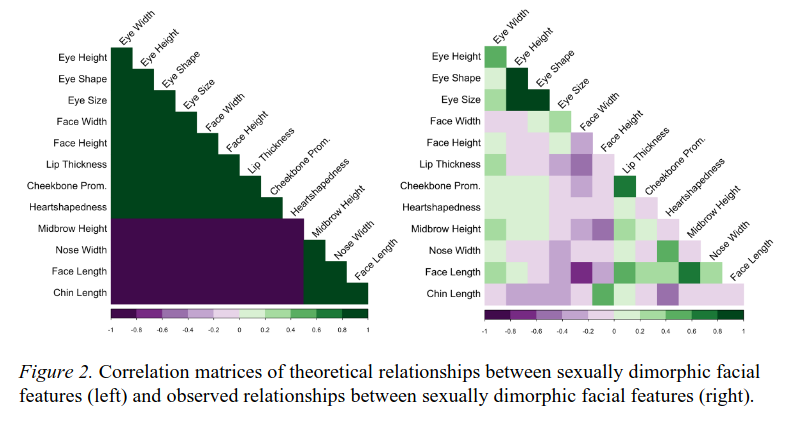
Let me digress in this paragraph to explain a point of methodology for the next study. In research on facial attractiveness, averageness is commonly observed to be attractive. I mentioned previously this refers to facial trait averageness, not decile scale (ie “he’s a 5”) ratings of attractiveness. I won’t cover averageness in this article, except to mention briefly that averageness is a much more consistent predictor of facial attractiveness than dimorphism (Clarkson et al., 2020; Rhodes, 2006). A great deal of facial attractiveness research on averageness uses computer edited composite faces. This means combining many faces to make an average face. Perhaps counterintuitive, but people find these composite faces attractive.
Scott & Penton-Voak (2011) looked at masculinity ratings of composite faces. Although composite faces are rated as more attractive, they are also rated as more masculine. Yet, we have seen that faces manipulated to be more masculine or dimorphic are rated as less attractive! This indicates that preferences for more feminized faces (or aversion to more masculinized faces) may not be an artifact of editing. Something else is going on.
Preferences for masculine dimorphic faces are contextual
That we see mixed results for sexually dimorphic faces may be explained in part by context. We have seen that individual-level or pair interrater agreement is lower than mean agreement. It would not be unwarranted to wonder if some women prefer masculine faces more, some less.
Individual preference for masculinity in a partner predicts a preference for masculine faces. DeBruine et al. (2006) found small-medium correlations with facial masculinity ratings, stated preference for masculinity in a partner (.30), and the perceived masculinity of women’s actual partners (.25), although the latter relationship was not statistically significant. Burris et al. (2011) found a similar relationship. Women who preferred masculine faces had partners with more masculine faces. The partners of these women also self-rated their own masculinity higher.
O’Connor et al. (2012) found that both a preference for masculinity, as well as a woman’s own (higher) level of attractiveness, predicted a preference for more masculine faces. However, the general preference was toward edited-feminized faces, consistent with past research showing an aversion to edited-masculine dimorphic faces.
Conversely, Penton-Voak et al. (2003) found that women who had more attractive faces as well as a more attractive width-to-hip ratio rated masculine faces as less attractive. More feminine male faces were preferred, particularly for long term relationships.
As in Penton-Voak et al., relationship status or relationship intention may predict ratings for dimorphic faces. Little et al. (2002) found preferences for masculinity in women who were not single, as well as women who were considering short term relationships. Stower et al. (2020) found that facial masculinity was preferred for long term relationships, but not short term relationships. As this shows a preference for masculinity in a relationship, it is also inconsistent with the dual mate hypothesis (a preference for masculinity only in short-term relationships).
Marcinkowska et al. (2008) found no relationship between a woman’s position in her menstrual cycle and a preference for facial masculinity, but did find a preference for masculinity in women who were pregnant or pre-menopausal. Dixson et al. (2018; 2018) found no relationship between menstrual cycle phase and preference for masculinity across two studies.
In the next section we will see similar relationships between facial masculinity measured by facial hair (beardness vs clean shaven) in preferences for both long and short term relationships.
As mentioned, the relationship between facial masculinity or dimorphism and relationship status, menstrual cycle position, and relationship intentions is inconsistent with the dual mate hypothesis, which stated that women should prefer more masculine “good genes” for short term relationships. We see instead that women seem to prefer masculinity in long term relationship contexts. This is more consistent with the newer and more parsimonious mate switching hypothesis (Buss et al., 2017), which allows for short term mate preferences to function as selection behaviors for potential long term mates. Basically, short term partners are potential long term partners — women thus seek the same traits in short term partners that they desire in long term mates.
Mixed results in preferences for facial dimorphism may also be explained by tradeoff theory (DeBruine, 2014): high facial dimorphism signals both positive (health, protection) and negative (aggression, low investment) traits. Consistent with this, Borras-Guevara et al. (2017) found that women who believe men are a greater threat to their children show a lower preference for facial masculinity.
Further supporting this, Geniole & McCormick (2013) controlled for perceived aggression and found that the negative relationship between facial dimorphism and attractiveness (-.09) was reversed (.35). This effect held true across three studies using both manipulated and natural faces.
Culture and facial dimorphism
As with attractiveness, we see degrees of variation in preferences for dimorphic faces across cultures. Pavlovič et al. (2021) found differences in Czech and Vietnamese preferences for masculine faces, both in Vietnamese individuals raised in the Czech Republic and Vietnamese individuals raised in Vietnam. Vietnamese women who were raised in the Czech Republic showed a greater preference for masculinity similar to native Czech individuals, while Vietnamese subjects raised in Vietnam did not. This indicates a cultural effect on facial masculinity preferences.
Kočnar et al. (2019) used cross-cultural samples from European and non-European populations. Mean ratings of facial attractiveness were between .5 to .9, similar to previous research showing agreement in mean attractiveness ratings. However, less dimorphic (more feminine) faces were preferred in European countries with higher Human Development Indices.
Fiala et al. (2021) compared preferences for facial dimorphism across five countries: Cameroon, Colombia, Czech Republic, Iran, and Turkey. Only samples from the Czech Republic (.44) and Colombia (.48) showed a preference for facial masculinity.
Scott et al. (2008) found a higher preference for masculine faces in a Malaysian sample, in addition to a higher preference for masculine faces in a short-term relationship context. Women who reported having past health issues were less likely to prefer masculine faces.
Marcinkowska et al. (2019) looked at a large sample (N = 4483) across 34 countries. The results were consistent with Kočnar et al.; women showed a preference for masculine faces in countries with higher Health Development Index, as well as high sociosexuality. However, there was no relationship with crime rate (contrary to the male-male competition hypothesis, which posits that more dimorphic traits should be preferred in environments with higher male competition).

This was also opposite of an earlier finding by DeBruine et al. (2010): subjects from low HDI countries preferred more masculine faces.
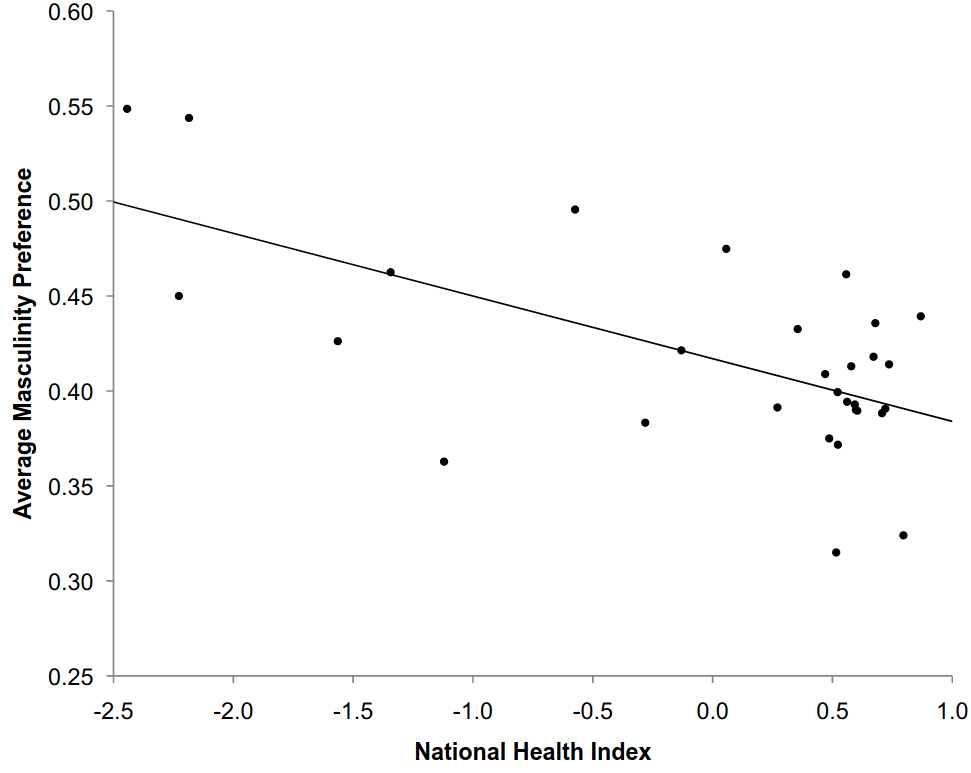
Borras-Guevara et al. (2017) reported that women who lived in more violent countries, or who had experienced more criminal violence (e.g. robbery), were less likely to prefer masculine faces.
You should start growing a beard
A key masculine dimorphic trait is facial hair. As the Gigachad has stubble in his photos this may have influenced ratings of attractiveness. That said, I was surprised. Female preferences for facial hair seem to be much more consistent than preferences for masculine facial dimorphism.
Neave & Shields (2008) found that light and dark stubble were rated as more attractive than clean-shaven faces, at .65 and .56 respectively. This amounts to about one half point higher for stubbled faces on a 7 point Likert scale. Dixson & Brooks (2013) similarly found that heavy stubble was rated more attractive than clean-shaven, lightly stubbled, and bearded faces. The increase in attractiveness for stubbled faces was about 1 point higher on a 5 point Likert scale.
In another study from Dixson et al. (2016) women indicated a preference for heavy stubble and there was an interaction with facial attractiveness.
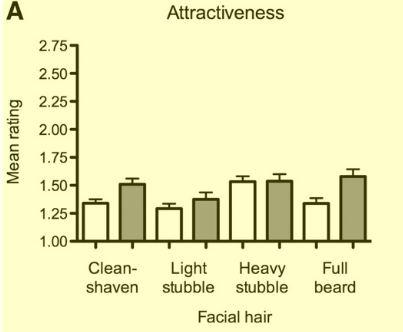
Dixson et al. (2017) further found a general preference for beards over clean-shaven faces. In this study there were also interactions with structural masculine dimorphism and facial hair. Bearded faces with smaller jaws were rated as more attractive than bearded faces with larger jaws, as well as clean-shaven faces with either large or small jaws. However, jaw size as an individual variable positively predicted facial attractiveness. Stower et al. (2020) similarly found that beards were rated as most attractive. A potential interpretation of this is that beards may be especially valuable for enhancing the attractiveness of less dimorphic faces.
In context, Clarkson et al. (2020) found that beards were rated as more attractive by women both for short term and long term relationships. A large study by Dixson et al. (2019, N = 2013) found that mothers preferred bearded men when judging a potential father and that postpartum women (women who recently gave birth) also preferred bearded men. This is consistent with Marcinkowska et al. (2008), previously mentioned, who found a preference for facial masculinity in pregnant women.
Dixson et al. (2019) also found cross-cultural preferences for facial hair, as well as individual difference preferences. Women who preferred higher masculinity also preferred bearded men. Women from countries with a higher Human Development Index, as well as a lower education index, preferred bearded men. Women who preferred bearded men also tended to be older.
Further highlighting the role of culture or environment in preferences for facial masculinity, I will end this section with a twin study from Verweij et al. (2012). As with Germine et al. (2015) in ratings of facial attractiveness, the heritability of preferences for facial dimorphism measured by beardedness was low. MZ twin preference was .38 and DZ twin preference was .11. Most of the variance in preferences for facial hair seems to be due to the nonshared environment.
I want to share one final chart from Dixson (2017) showing the interaction with facial hair and facial masculinity. All types of facial hair were preferred over clean-shaven faces:
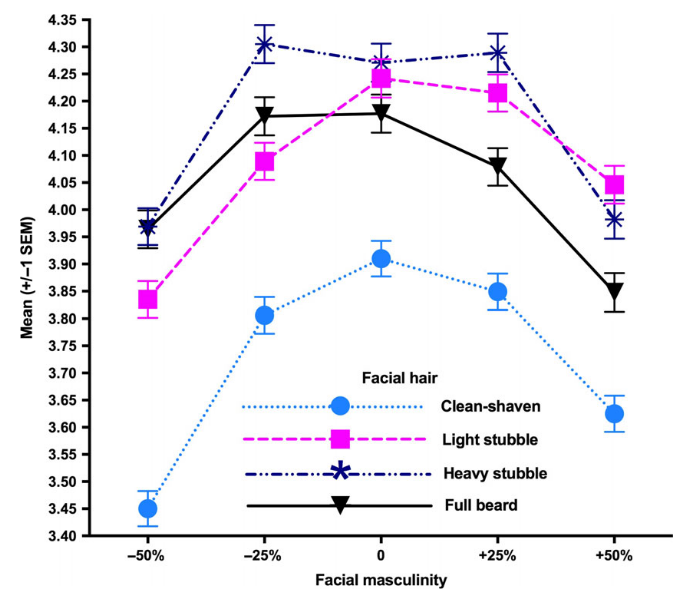
Miscellaneous findings
Reflecting back on the Gigachad results, you may ask yourself: who is right, men or women? Well, if you are a heterosexual man and you are interested in how women rate you, then you may want to prioritize female ratings. In a more general sense, Graziano et al. (1993) found that both men and women agreed that women tended to be better judges of facial attractiveness.
However, if you are a gay man you may prefer to prioritize male ratings. The findings from my Gigachad survey are also consistent with gay male preferences for masculine faces. Welling et al. (2013) found that gay men had a much higher preference for exaggeratedly masculine faces. As I did not control for sexual orientation in my survey, this may have also influenced the outcome.
Nedelec & Beaver (2011) also found that men are more likely to rate male faces at the highest end of a Likert scale (Attractive or Very Attractive), as well as less likely to rate male faces very low (Highly Unattractive). This effect may be reflected in the sex distribution of ratings of the Gigachad.
A point from Yang et al. (2015) is that we should also keep the attractiveness-dimorphism interaction in mind. Attractive-masculine faces were rated as more attractive than attractive-androgynous faces, but unattractive-masculine faces were rated as less attractive than androgynous faces. Or, in other words, an unattractive face is still unattractive regardless of its degree of dimorphism.
Finally, revisiting facial hair, if you want to grow a beard you may need to be able to grow a full beard. Dixson et al. (2016) found that clean-shaven faces were more attractive than patchy facial hair. Heavier facial hair was more attractive and was more likely to be picked about 25-30% of the time.
The neuroscience of facial attractiveness
I wanted to write a brief section on this because I would like to focus more on the neuroscience of attractiveness in the future. Additionally, although we see high variation in within-individual ratings of attractiveness I don’t want people to misinterpret the results as evidence for the nonexistence of objective beauty. The neuroscience of facial attractiveness may also help to explain sex differences in why the Gigachad is viewed differently by men and women.
Even from a young age, children and adults agree on what an attractive face is (Ma et al., 2013). Electroencephalography (EEGs), which measures event-related potentials (ERPs), shows a higher late-positive potential (LPP) when individuals are shown attractive faces (Thiruschselvam et al., 2016). LPPs are ERPs that emerge in the visual cortical area in response to emotional stimuli. In Thiruschselvam et al., we see LPPs spike when viewing an attractive face; LPPs spike even higher when primed with an attractive face. The relationship remained for self-reported facial attractiveness as well. In other words, the LPP emerges both when faces are objectively (rated by third party judges) or subjectively (rated by the self) attractive.
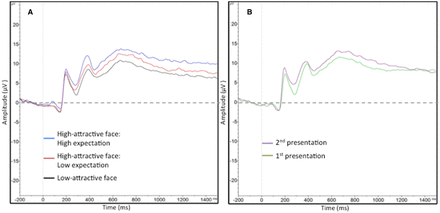
Carrito et al. (2018) similarly found different LPP signals (EPN, LPN and LPP) for men and women when viewing opposite-sex faces.
Functional magnetic resonance imaging (fMRIs) gives us images of the brain based on blood flow. We can see activation in the nucleus accumbens (NAcc) and the orbito-frontal cortex (OFC) when viewing attractive faces (Cloutier et al., 2008). The NAcc is a limbic system component that has a role in reward response and emotion. The OFC is also a limbic system component. In Cloutier et al. we see sex differences as well: activation in the OFC for men that exists to a lesser degree in women. This activation was linear; more blood flow activated more imaging when participants were exposed to more attractive faces.
Magnetoencephalography (MEG) measures the electric field generated by neurons. Tiedt et al. (2013) found a right-lateralized M170-component in occipito-temporal sensor clusters for men, but bilateral activation for women. The occipito-temporal cortex is related to conscious processing, perception and pattern recognition. It also has a role in some voluntary attentive behavior (for example, reading). In Tiedt et al., men viewed faces more holistically (viewed the entire face) while women viewed specific features more. MEG also indicated more male interest in opposite-sex faces.
Chatterjee et al. (2009) found activity in the ventral occipital in response to facial beauty even when unattentive (during a facial recognition task), but more widely distributed activity across the entire brain when attentive to facial beauty. In this we see both a distinct involuntary or unconscious response to facial beauty and an attention-driven or conscious response.
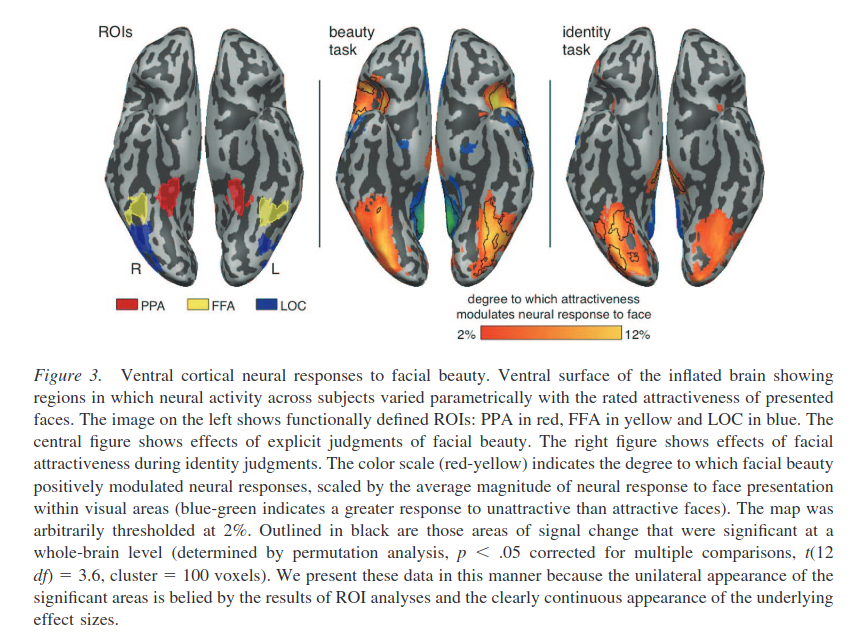
Tsikandilakis et al. (2019) also found that attractive faces were identified more quickly than unattractive faces in a facial identification task, indicating potential processing of facial attractiveness before conscious awareness.
For a good review on the neuroscience of facial beauty I would recommend Hahn & Perrett (2014), “Neural and behavioral responses to attractiveness in adult and infant faces.” (PDF)
The whitepill of facial attractiveness research
Across datasets of faces, we have seen that mean interrater correlation for facial attractiveness is high. This means that people tend to rate faces similarly on average. Beauty, as it turns out, is not subjective. Or, at least, beauty is not random.
Bad news if you’re rated poorly? Maybe not.
We have also seen that there is a great deal of variation in how individual faces are rated. Between-individual agreement is lower than mean agreement. The Gigachad results may help you to visualize this effect. He may be unattractive to most women, he may be unattractive on average, but he is still attractive to enough women.
The Gigachad was related below average, but you would be misled to believe that he is a hopeless incel based on his mean rating. Many women do find him attractive. You can see this in the distribution of scores.
It may not have been most women, but it was many. It was plenty. You don’t need most women to find you attractive to be successful in dating. You don’t even need a majority. You only need to find one woman who finds you attractive. High variation in individual attractiveness ratings means most men will be found attractive by someone. This may help to explain why most men are in relationships and why most men are having sex, despite most men not being rated highly on Likert scales (as we have seen in the OKCupid dataset, for example).
You are an individual face. Just because you paid a YouTuber $50 to tell you that you’re a 4/10 does not mean that is how all, or even most, women will view you. Just because Photofeeler gave you a score of 3.42/10 does not mean that there is not a large cohort of women who will find you facially attractive.
Remember the ecological fallacy in statistics — means don’t generalize to individual data points.
Importantly, when we are looking at facial attractiveness ratings, means can be an especially poor metric for generalizing to where individual data points fall given that these ratings may not follow a normal distribution.
Further, we have seen from the current survey and past literature that men and women view faces differently. While we do see good average agreement between male and female ratings of male faces, there are substantial differences. You should be extra skeptical of ratings given to you by men (if you are a man and you want to know if women find you attractive).
A final point on beards. Research showing a preference for bearded faces was more consistent than I expected it to be. It is often said that you can’t change your face, but growing a beard is one way you may be able to increase your attractiveness between 10-20%, or to bump your attractiveness up by 1 point on a 5 or 7 point scale.
Summary of points
- Most women did not find the Gigachad attractive, but most men did.
- Mean interrater agreement on facial attractiveness is high.
- Between-individual agreement on facial attractiveness is lower than mean agreement.
- Environmental contributions to perceptions of facial attractiveness are high.
- Preferences for facial dimorphism (masculinity) are mixed.
- Low preferences for facial masculinity in research may be due to methodology using edited photos.
- Multiple contextual variables contribute to a preference for facial masculinity when it exists.
- Facial hair is viewed as more attractive than clean-shaven faces on average.
References
Borras-Guevara, M. L., Batres, C., & Perrett, D. I. (2017). Aggressor or protector? Experiences and perceptions of violence predict preferences for masculinity. Evolution and Human Behavior, 38(4), 481-489.
Bronstad, P. M., & Russell, R. (2007). Beauty is in the ‘we’of the beholder: Greater agreement on facial attractiveness among close relations. Perception, 36(11), 1674-1681.
Burriss, R. P., Welling, L. L., & Puts, D. A. (2011). Mate-preference drives mate-choice: Men’s self-rated masculinity predicts their female partner’s preference for masculinity. Personality and Individual Differences, 51(8), 1023-1027.
Buss, D. M., Goetz, C., Duntley, J. D., Asao, K., & Conroy-Beam, D. (2017). The mate switching hypothesis. Personality and Individual Differences, 104, 143-149.
Carrito, M. L., Bem-Haja, P., Silva, C. F., Perrett, D. I., & Santos, I. M. (2018). Event-related potentials modulated by the perception of sexual dimorphism: The influence of attractiveness and sex of faces. Biological Psychology, 137, 1-11.
Chatterjee, A., Thomas, A., Smith, S. E., & Aguirre, G. K. (2009). The neural response to facial attractiveness. Neuropsychology, 23(2), 135.
Chen, L., Jiang, J., Ren, Z., & Yuan, H.. (2017). A meta-analysis of preference for sexual dimorphism of male’s face. Advances in Psychological Science, 25(4), 553.
Clarkson, T. R., Sidari, M. J., Sains, R., Alexander, M., Harrison, M., Mefodeva, V., … & Dixson, B. J. (2020). A multivariate analysis of women’s mating strategies and sexual selection on men’s facial morphology. Royal Society Open Science, 7(1), 191209.
Cloutier, J., Heatherton, T. F., Whalen, P. J., & Kelley, W. M. (2008). Are attractive people rewarding? Sex differences in the neural substrates of facial attractiveness. Journal of cognitive neuroscience, 20(6), 941-951.
Coetzee, V., Greeff, J. M., Stephen, I. D., & Perrett, D. I. (2014). Cross-cultural agreement in facial attractiveness preferences: The role of ethnicity and gender. PloS one, 9(7), e99629.
DeBruine, L. M., Jones, B. C., Little, A. C., Boothroyd, L. G., Perrett, D. I., Penton-Voak, I. S., … & Tiddeman, B. P. (2006). Correlated preferences for facial masculinity and ideal or actual partner’s masculinity. Proceedings of the Royal Society B: Biological Sciences, 273(1592), 1355-1360.
DeBruine, L. M., Jones, B. C., Smith, F. G., & Little, A. C. (2010). Are attractive men’s faces masculine or feminine? The importance of controlling confounds in face stimuli. Journal of Experimental Psychology: Human Perception and Performance, 36(3), 751.
DeBruine, L. M., Jones, B. C., Crawford, J. R., Welling, L. L., & Little, A. C. (2010). The health of a nation predicts their mate preferences: cross-cultural variation in women’s preferences for masculinized male faces. Proceedings of the Royal Society B: Biological Sciences, 277(1692), 2405-2410.
DeBruine, L. M. (2014). Women’s preferences for male facial features. In Evolutionary perspectives on human sexual psychology and behavior (pp. 261-275). Springer, New York, NY.
de Lurdes Carrito, M., dos Santos, I. M. B., Lefevre, C. E., Whitehead, R. D., da Silva, C. F., & Perrett, D. I. (2016). The role of sexually dimorphic skin colour and shape in attractiveness of male faces. Evolution and Human Behavior, 37(2), 125-133.
Dixson, B. J., & Brooks, R. C. (2013). The role of facial hair in women’s perceptions of men’s attractiveness, health, masculinity and parenting abilities. Evolution and Human Behavior, 34(3), 236-241.
Dixson, B. J., Sulikowski, D., Gouda‐Vossos, A., Rantala, M. J., & Brooks, R. C. (2016). The masculinity paradox: facial masculinity and beardedness interact to determine women’s ratings of men’s facial attractiveness. Journal of Evolutionary Biology, 29(11), 2311-2320.
Dixson, B. J., & Rantala, M. J. (2016). The role of facial and body hair distribution in women’s judgments of men’s sexual attractiveness. Archives of sexual behavior, 45(4), 877-889.
Dixson, B. J., Lee, A. J., Sherlock, J. M., & Talamas, S. N. (2017). Beneath the beard: do facial morphometrics influence the strength of judgments of men’s beardedness?. Evolution and Human Behavior, 38(2), 164-174.
Dixson, B. J., Blake, K. R., Denson, T. F., Gooda-Vossos, A., O’Dean, S. M., Sulikowski, D., … & Brooks, R. C. (2018). The role of mating context and fecundability in women’s preferences for men’s facial masculinity and beardedness. Psychoneuroendocrinology, 93, 90-102.
Dixson, B. J., Lee, A. J., Blake, K. R., Jasienska, G., & Marcinkowska, U. M. (2018). Women’s preferences for men’s beards show no relation to their ovarian cycle phase and sex hormone levels. Hormones and behavior, 97, 137-144.
Dixson, B. J., Rantala, M. J., & Brooks, R. C. (2019). Cross-cultural variation in women’s preferences for men’s body hair. Adaptive Human Behavior and Physiology, 5(2), 131-147.
Dixson, B. J., Kennedy-Costantini, S., Lee, A. J., & Nelson, N. L. (2019). Mothers are sensitive to men’s beards as a potential cue of paternal investment. Hormones and behavior, 113, 55-66.
Fiala, V., Třebický, V., Pazhoohi, F., Leongómez, J. D., Tureček, P., Saribay, S. A., … & Kleisner, K. (2021). Facial attractiveness and preference of sexual dimorphism: A comparison across five populations. Evolutionary Human Sciences, 3.
Geniole, S. N., & McCormick, C. M. (2013). Taking control of aggression: Perceptions of aggression suppress the link between perceptions of facial masculinity and attractiveness. Evolutionary Psychology, 11(5), 147470491301100507.
Germine, L., Russell, R., Bronstad, P. M., Blokland, G. A., Smoller, J. W., Kwok, H., … & Wilmer, J. B. (2015). Individual aesthetic preferences for faces are shaped mostly by environments, not genes. Current Biology, 25(20), 2684-2689.
Graziano, W. G., Jensen-Campbell, L. A., Shebilske, L. J., & Lundgren, S. R. (1993). Social influence, sex differences, and judgments of beauty: Putting the interpersonal back in interpersonal attraction. Journal of personality and social psychology, 65(3), 522.
Hanel, P. H., & Vione, K. C. (2016). Do student samples provide an accurate estimate of the general public?. PloS one, 11(12), e0168354.
Hahn, A. C., & Perrett, D. I. (2014). Neural and behavioral responses to attractiveness in adult and infant faces. Neuroscience & Biobehavioral Reviews, 46, 591-603.
Hester, N., Jones, B. C., & Hehman, E. (2021). Perceived femininity and masculinity contribute independently to facial impressions. Journal of Experimental Psychology: General, 150(6), 1147.
Hill, A. K., Hunt, J., Welling, L. L., Cardenas, R. A., Rotella, M. A., Wheatley, J. R., … & Puts, D. A. (2013). Quantifying the strength and form of sexual selection on men’s traits. Evolution and Human Behavior, 34(5), 334-341.
Hönekopp, J. (2006). Once more: is beauty in the eye of the beholder? Relative contributions of private and shared taste to judgments of facial attractiveness. Journal of Experimental Psychology: Human Perception and Performance, 32(2), 199.
Jach, Ł., & Moroń, M. (2020). I can wear a beard, but you should shave… Preferences for men’s facial hair from the perspective of both sexes. Evolutionary Psychology, 18(4), 1474704920961728.
Jones, D., & Hill, K. (1993). Criteria of facial attractiveness in five populations. Human Nature, 4(3), 271-296.
Kočnar, T., Saribay, S. A., & Kleisner, K. (2019). Perceived attractiveness of Czech faces across 10 cultures: Associations with sexual shape dimorphism, averageness, fluctuating asymmetry, and eye color. PLoS One, 14(11), e0225549.
Kościński, K. (2010). Do they know what they like? Intra-individual variation of female facial preferences. Journal of Evolutionary Psychology, 8(1), 23-55.
Langlois, J. H., Kalakanis, L., Rubenstein, A. J., Larson, A., Hallam, M., & Smoot, M. (2000). Maxims or myths of beauty? A meta-analytic and theoretical review. Psychological bulletin, 126(3), 390.
Lavan, N., Mileva, M., Burton, A. M., Young, A. W., & McGettigan, C. (2021). Trait evaluations of faces and voices: Comparing within-and between-person variability. Journal of Experimental Psychology: General.
Li, Z., Lei, X., Yan, X., Hu, Z., & Liu, H. (2021). Attractiveness Evaluation and Identity of Self-face: The Effect of Sexual Dimorphism. i-Perception, 12(6), 20416695211058799.
Little, A. C., Jones, B. C., Penton-Voak, I. S., Burt, D. M., & Perrett, D. I. (2002). Partnership status and the temporal context of relationships influence human female preferences for sexual dimorphism in male face shape. Proceedings of the Royal Society of Lon
Ma, F., Xu, F., & Luo, X. (2016). Children’s facial trustworthiness judgments: Agreement and relationship with facial attractiveness. Frontiers in psychology, 7, 499.
Marcinkowska, U. M., Jasienska, G., & Prokop, P. (2018). A comparison of masculinity facial preference among naturally cycling, pregnant, lactating, and post-menopausal women. Archives of sexual behavior, 47(5), 1367-1374.
Marcinkowska, U. M., Rantala, M. J., Lee, A. J., Kozlov, M. V., Aavik, T., Cai, H., … & Dixson, B. J. (2019). Women’s preferences for men’s facial masculinity are strongest under favorable ecological conditions. Scientific Reports, 9(1), 1-10.
Marcus, D. K., & Miller, R. S. (2003). Sex differences in judgments of physical attractiveness: A social relations analysis. Personality and Social Psychology Bulletin, 29(3), 325-335.
Neave, N., & Shields, K. (2008). The effects of facial hair manipulation on female perceptions of attractiveness, masculinity, and dominance in male faces. Personality and Individual Differences, 45(5), 373-377.
Nedelec, J. L., & Beaver, K. M. (2011). Beauty is in the sex of the beholder: An examination of the effects of interviewer characteristics on assessments of respondent attractiveness. Personality and Individual Differences, 51(8), 930-934.
O’Connor, J. J., Feinberg, D. R., Fraccaro, P. J., Borak, D. J., Tigue, C. C., Re, D. E., … & Tiddeman, B. (2012). Female preferences for male vocal and facial masculinity in videos. Ethology, 118(4), 321-330.
Pavlovič, O., Fiala, V., & Kleisner, K. (2021). Environmental convergence in facial preferences: A cross-group comparison of Asian Vietnamese, Czech Vietnamese, and Czechs. Scientific reports, 11(1), 1-10.
Penton-Voak, I. S., Little, A. C., Jones, B. C., Burt, D. M., Tiddeman, B. P., & Perrett, D. I. (2003). Female condition influences preferences for sexual dimorphism in faces of male humans (Homo sapiens). Journal of Comparative Psychology, 117(3), 264.
Rennels, J. L., Bronstad, P. M., & Langlois, J. H. (2008). Are attractive men’s faces masculine or feminine? The importance of type of facial stimuli. Journal of Experimental Psychology: Human Perception and Performance, 34(4), 884.
Rhodes, G. (2006). The evolutionary psychology of facial beauty. Annual review of psychology, 57, 199.
Scott, I., Swami, V., Josephson, S. C., & Penton-Voak, I. S. (2008). Context-dependent preferences for facial dimorphism in a rural Malaysian population. Evolution and Human Behavior, 29(4), 289-296.
Scott, I. M., Pound, N., Stephen, I. D., Clark, A. P., & Penton-Voak, I. S. (2010). Does masculinity matter? The contribution of masculine face shape to male attractiveness in humans. PLoS one, 5(10), e13585.
Scott, I. M., & Penton-Voak, I. S. (2011). The validity of composite photographs for assessing masculinity preferences. Perception, 40(3), 323-331.
Stower, R. E., Lee, A. J., McIntosh, T. L., Sidari, M. J., Sherlock, J. M., & Dixson, B. J. (2020). Mating strategies and the masculinity paradox: How relationship context, relationship status, and sociosexuality shape women’s preferences for facial masculinity and beardedness. Archives of Sexual Behavior, 49(3), 809-820.
Straus, M. A. (2009). Validity of cross-national research using unrepresentative convenience samples. Survey Practice, 2(6), 1-6.
Thiruchselvam, R., Harper, J., & Homer, A. L. (2016). Beauty is in the belief of the beholder: cognitive influences on the neural response to facial attractiveness. Social cognitive and affective neuroscience, 11(12), 1999-2008.
Thompson, A. E., & O’Sullivan, L. F. (2013). The relationship between men’s facial masculinity and women’s judgments of value as a potential romantic partner. The Canadian Journal of Human Sexuality, 22(1), 5-12.
Tiedt, H. O., Weber, J. E., Pauls, A., Beier, K. M., & Lueschow, A. (2013). Sex-differences of face coding: evidence from larger right hemispheric M170 in men and dipole source modelling. PloS one, 8(7), e69107.
Tsikandilakis, M., Bali, P., & Chapman, P. (2019). Beauty is in the eye of the beholder: The appraisal of facial attractiveness and its relation to conscious awareness. Perception, 48(1), 72-92.
Verweij, K. J., Burri, A. V., & Zietsch, B. P. (2012). Evidence for genetic variation in human mate preferences for sexually dimorphic physical traits. PloS one, 7(11), e49294.
Welling, L. L., Singh, K., Puts, D. A., Jones, B. C., & Burriss, R. P. (2013). Self-reported sexual desire in homosexual men and women predicts preferences for sexually dimorphic facial cues. Archives of Sexual Behavior, 42(5), 785-791.
Yang, T., Chen, H., Hu, Y., Zheng, Y., & Wang, W. (2015). Preferences for sexual dimorphism on attractiveness levels: An eye-tracking study. Personality and Individual Differences, 77, 179-185.
Zebrowitz, L. A., Montepare, J. M., & Lee, H. K. (1993). They don’t all look alike: Individual impressions of other racial groups. Journal of personality and social psychology, 65(1), 85.
Zebrowitz, L. A., Wang, R., Bronstad, P. M., Eisenberg, D., Undurraga, E., Reyes-García, V., & Godoy, R. (2012). First impressions from faces among US and culturally isolated Tsimane’ people in the Bolivian rainforest. Journal of Cross-Cultural Psychology, 43(1), 119-134.
Zuo, B., Wen, F., & Wu, Y. (2019). Sex differences in mate retention and mate quality enhancement: The effect of facial sexual dimorphism cues on willingness to introduce a new friend to one’s partner. Archives of Sexual Behavior, 48(6), 1785-1794.
26 comments
What? I hope this is a memepaper. “According to Incel.wiki, “Gigachad is a 10/10 Chad who is within the top 0.01% of physical attractiveness.” Incelwiki.org similarly says, “[Gigachad] typically ranks as a “10” on the decile scale.” These were two of my top search results for “Gigachad” on Google. They capture the popular meme well: the Gigachad is the epitome of the physically attractive man.” That is it. Is is a meme. The joke went over your head. So autistic.
What the bleepers. You are so cool I love your bleeping work. Can we hang sometime. I am open on tuesdays and thursdays from 22:30 to 23:46. Maybe we can grab some Chinese spider crab at Ashtons sweat shop in Costa Rica Xoxoxoxoxoxoxoxoxox. Ttys my number is 453-235-5569. Call me maybe.
Holy shit I will dm you! I like booty.
Thatt is very inappropriate! BBooty clapper. vene thpugh i wish i could clap you very hard
Imma clap yo BOOTY!!! you well lub et! imma clap dem cheeks hard as fuck! Imma shmash it too.
…
You are so lost. Do you honestly think Gigachad gives a fuck about what women think about him?
Are you a gigachad activist? Im a botty clapping activist. Imma clap does juicy cheeks!!! Nobody gunaa stop me
Stop the booty clapping please. That is sexual assault! If you don´t stop we will fid your IP adress.
This is what I was gonna say lol
i im going to crine you anallly foul an the il steaul ur vbux >:)
Imma bringya ta jail buddy boy1
V bux? Is that from that very inaprpriate game Fortnite? With guns and violence? U should not be playing that game. Im a part of a group of moms trying to get that game rated mature and BANNED!
Susan heres some robux and vbux buy yerself somethin tight instead of going oin the computer without zaddys permission. >:()
Does anyone here watch deepfake porn videos of giggachad getting his booty clapped like really hard.
Yeahhh I do that all the time and it gets me so hard ambatukam right now ambassing oh ambassing ahhohahhhaohhhahh
I don’t know if gigachad is preferred or not by females,.but I want to more a fact:
In section “culture and facial attractiveness” paragraph, as you wrote, studies demostrated that not-occidental peoples agree on beauty western standard. There is less agreement when westerns rate other cultures, but that’s a different story. So the western beauty standard are the most objective. And if they are objective, so, beauty is universal and not culturally determined.
(Sorry for my English I’m Italian)
Are you a gorl? Cuz i lub clapping italian gorls real hard. in the booty.
Are you a gorl? Cuz i lub clapping italian gorls real hard. in the booty. You can come to my place and we can clap for as long as iwannt!
Gigachad is supposed to be an exaggeration of the male ideal, that’s why he’s funny. He’s not supposed to be genuinely hot, fuck’s sake, you went through all that trouble for nothing
Well I wanna butt fuck him haaaaard.
What makes him a Gigachad is that he doesn’t give a fuq about these women.
I am in love with Gigachad and I will NOT tolerate this kind of slander about that absolute marvel of a man.
In the world of LEGO bricks, we discover a fascinating landscape of aesthetic preferences, much like discussions about facial attractiveness. The similarity among reviewers regarding facial beauty is evident, but interpersonal agreements are more diverse. In this brick experiment, most women did not find Gigachad charming, while, for the majority of men, he was attractive.
Analysis indicates that environmental influences play a crucial role in the perception of facial attractiveness. Here, much like in the LEGO world, context is key. Preferences for masculinity are mixed, and low preferences for masculinity may result from a methodology using edited photos. We find that contextual variables contribute to preferences for masculinity when they exist.
Similar to selecting the right bricks in building a LEGO construction, the choice of facial hair or its absence influences the assessment of attractiveness. In our set, the results suggest that facial hair is perceived as more attractive than clean-shaven faces. It’s like with LEGO bricks – every detail matters and affects the final outcome, creating a unique aesthetic that speaks to various tastes and preferences.